带有缩放显示的Windows环境下的Java多显示器处理?
tl;博士
在Windows 10下,如果我将辅助显示器放在主显示器的右侧,并将缩放(例如150%)应用于次要显示器,则显示坐标(由Java API返回)重叠,而不是让显示边界并排放置。换句话说,如果我缓慢地将鼠标从主屏幕的左边边缘移动到次要的右侧边缘,Java的API MouseInfo.getPointerInfo().getLocation()将从0到1920返回一个增加的X位置,然后当光标进入第二个屏幕时,值会跳回1280,然后再次增加到2560。因此,1280年至1920年的范围是两次返回,为不同的地区。
在文章的最后,我已经包括了一个(更新的)演示,使问题变得明显。不要犹豫,试一试,然后报告给你。
长版本:
这篇文章给出了(也)很多上下文,但也是为了分享我在搜索主题时学到的东西。
首先,为什么要费心呢?因为我正在用Java构建一个屏幕捕捉应用程序,它需要正确处理多个显示配置,包括应用Windows缩放功能的显示器。
使用Java (GraphicsEnvironment.getLocalGraphicsEnvironment().getScreenDevices()),只要缩放率为100%,就可以观察到主显示器的左上角位于原点(0,0),而其他显示器的坐标为"next“。
下面的图片是使用文章末尾的代码制作的。
如果我们有2个全高清显示器,主显示器的左上角是(0,0),而.
- 如果二级计算机位于其右侧,处于同一级别,则其左上角为(1920,0):
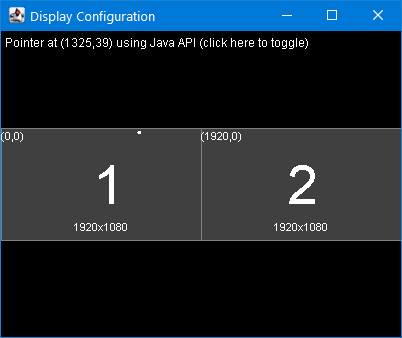
- 如果次级位于其左侧,则其左上角为(-1920,0):
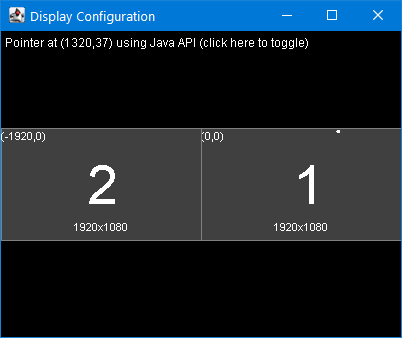
- 如果次级位于下面,水平对齐,则其左上角为(0,1080):
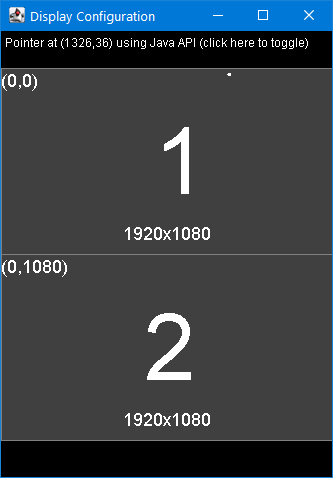
- 如果次级位于上方,水平对齐,则其左上角为(0,-1080):
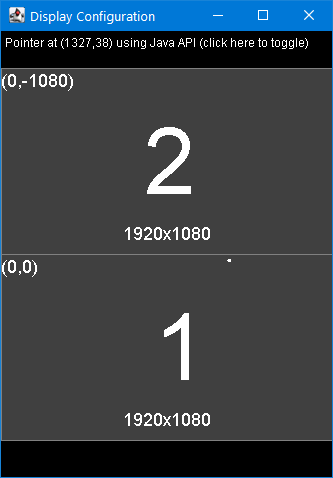
- 如果显示不对齐,则依此类推:
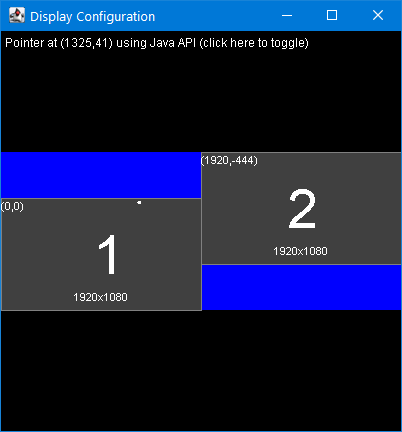
- 或以不同的决议:
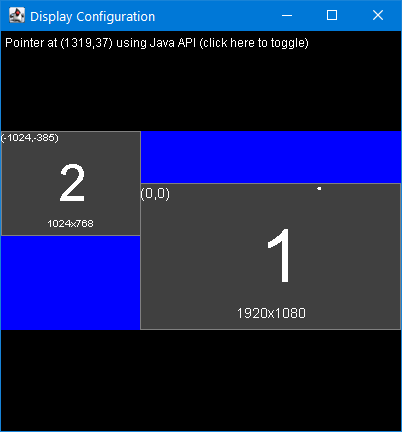
但是,如果二次显示被缩放,事情就会出错:似乎缩放因子不仅应用于其维度,而且还应用于其原点,后者更接近(0,0)。
如果中学在左边,那就说得通了。例如,当二级1920x1080的比例为150%时,它使逻辑1280x720定位于(-1280,0):
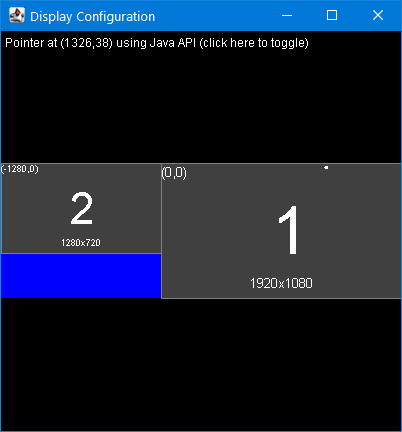
但是,如果次生子位于右侧,则原点也是缩放的到(1280,0),离原点越来越近,并导致其“重叠”主源:
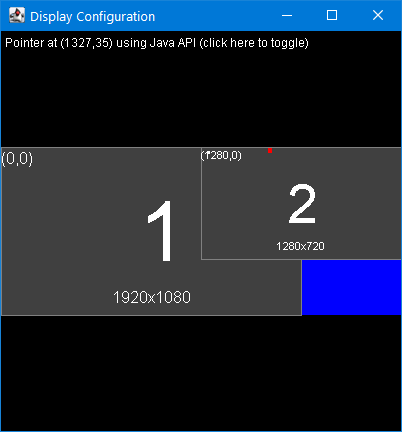
换句话说,如果鼠标位于(1800,0) --见上面的红点--我看不出它实际上是定位在第一个显示器的右边(从右边的120 of )还是在第二个显示器的左边(左边边缘的520 of )。在这种情况下,当鼠标从主显示器移动到辅助显示器时,当鼠标到达主显示器的边框时,鼠标的X位置“跳回”。
在屏幕上定位窗口也是如此。如果我将一个对话框的X位置设置为1800,我就无法知道它将在哪里打开。
经过多次浏览后,就像这个的一些答案表明,查询Windows的唯一方法是使用本机调用。实际上,使用JNA可以得到显示器的物理大小(尽管答案似乎表明调用应该返回逻辑大小)。也就是说,JNA调用忽略缩放因子,当缩放达到100%时,它的行为与Java完全一样:

那我是不是漏掉了什么?
不知道缩放因子是一个小问题,但不能判断鼠标的显示已经结束,或者不能在我想要的显示器上定位窗口,这对我来说是一个真正的问题。是爪哇虫吗?
注意:下面是上面使用的应用程序的代码,在Windows1064b上运行OpenJDK14。它显示了Java感知到的显示设置和鼠标位置的缩小版本。如果您单击并拖动小矩形,它还可以在实际屏幕上放置和移动一个小对话框。信用: UI的灵感来源于WheresMyMouse代码发布的这里。
实际上,代码只使用Java。如果您想与JNA进行比较,请搜索标记为"JNA_ONLY“的4个块,取消注释,然后添加jna库。然后,该演示将在JNA和Java之间切换,以便在每次右击时显示屏幕边界和鼠标光标。在此版本中,对话框定位从不使用JNA。
// JNA_ONLY
//import com.sun.jna.platform.win32.User32;
//import com.sun.jna.platform.win32.WinDef;
//import com.sun.jna.platform.win32.WinUser;
import javax.swing.*;
import java.awt.*;
import java.awt.event.MouseAdapter;
import java.awt.event.MouseEvent;
import java.awt.font.FontRenderContext;
import java.awt.font.TextLayout;
import java.awt.geom.Rectangle2D;
import java.util.ArrayList;
import java.util.List;
/**
* Java multi-display detection and analysis.
* UI idea based on WheresMyMouse - https://stackoverflow.com/a/21592711/13551878
*/
public class ShowDisplays {
private static boolean useJna = false;
public static void main(String[] args) {
EventQueue.invokeLater(() -> {
JFrame frame = new JFrame("Display Configuration");
frame.setDefaultCloseOperation(JFrame.EXIT_ON_CLOSE);
frame.setLayout(new BorderLayout());
frame.add(new TestPane());
frame.pack();
frame.setLocationRelativeTo(null);
frame.setVisible(true);
});
}
public static class TestPane extends JPanel {
private List<Rectangle> screenBounds;
JDialog dlg;
public TestPane() {
screenBounds = getScreenBounds();
// refresh screen details every second to reflect changes in Windows Preferences in "real time"
new Timer(1000, e -> screenBounds = getScreenBounds()).start();
// Refresh mouse position at 25fps
new Timer(40, e -> repaint()).start();
MouseAdapter mouseAdapter = new MouseAdapter() {
public void mouseClicked(MouseEvent e) {
if (e.getButton() != MouseEvent.BUTTON1) {
useJna = !useJna;
repaint();
}
}
@Override
public void mousePressed(MouseEvent e) {
System.out.println(e.getButton());
if (e.getButton() == MouseEvent.BUTTON1) {
if (!dlg.isVisible()) {
dlg.setVisible(true);
}
moveDialogTo(e.getPoint());
}
}
@Override
public void mouseDragged(MouseEvent e) {
moveDialogTo(e.getPoint());
}
private void moveDialogTo(Point mouseLocation) {
final Rectangle surroundingRectangle = getSurroundingRectangle(screenBounds);
double scaleFactor = Math.min((double) getWidth() / surroundingRectangle.width, (double) getHeight() / surroundingRectangle.height);
int xOffset = (getWidth() - (int) (surroundingRectangle.width * scaleFactor)) / 2;
int yOffset = (getHeight() - (int) (surroundingRectangle.height * scaleFactor)) / 2;
int screenX = surroundingRectangle.x + (int) ((mouseLocation.x - xOffset) / scaleFactor);
int screenY = surroundingRectangle.y + (int) ((mouseLocation.y - yOffset) / scaleFactor);
dlg.setLocation(screenX - dlg.getWidth() / 2, screenY - dlg.getHeight() / 2);
}
};
addMouseListener(mouseAdapter);
addMouseMotionListener(mouseAdapter);
// Prepare the test dialog
dlg = new JDialog();
dlg.setTitle("Here");
dlg.setSize(50, 50);
dlg.setDefaultCloseOperation(JFrame.HIDE_ON_CLOSE);
}
@Override
public Dimension getPreferredSize() {
return new Dimension(400, 400);
}
@Override
protected void paintComponent(Graphics g) {
super.paintComponent(g);
Graphics2D g2d = (Graphics2D) g.create();
// Mouse position
Point mousePoint = getMouseLocation();
g2d.setColor(Color.BLACK);
g2d.fillRect(0, 0, getWidth(), getHeight());
final Rectangle surroundingRectangle = getSurroundingRectangle(screenBounds);
double scaleFactor = Math.min((double) getWidth() / surroundingRectangle.width, (double) getHeight() / surroundingRectangle.height);
int xOffset = (getWidth() - (int) (surroundingRectangle.width * scaleFactor)) / 2;
int yOffset = (getHeight() - (int) (surroundingRectangle.height * scaleFactor)) / 2;
g2d.setColor(Color.BLUE);
g2d.fillRect(xOffset, yOffset, (int) (surroundingRectangle.width * scaleFactor), (int) (surroundingRectangle.height * scaleFactor));
Font defaultFont = g2d.getFont();
for (int screenIndex = 0; screenIndex < screenBounds.size(); screenIndex++) {
Rectangle screen = screenBounds.get(screenIndex);
Rectangle scaledRectangle = new Rectangle(
xOffset + (int) ((screen.x - surroundingRectangle.x) * scaleFactor),
yOffset + (int) ((screen.y - surroundingRectangle.y) * scaleFactor),
(int) (screen.width * scaleFactor),
(int) (screen.height * scaleFactor));
// System.out.println(screen + " x " + scaleFactor + " -> " + scaledRectangle);
g2d.setColor(Color.DARK_GRAY);
g2d.fill(scaledRectangle);
g2d.setColor(Color.GRAY);
g2d.draw(scaledRectangle);
// Screen text details
g2d.setColor(Color.WHITE);
// Display number
final Font largeFont = new Font(defaultFont.getName(), defaultFont.getStyle(), (int) (screen.height * scaleFactor) / 2);
g2d.setFont(largeFont);
String label = String.valueOf(screenIndex + 1);
FontRenderContext frc = g2d.getFontRenderContext();
TextLayout layout = new TextLayout(label, largeFont, frc);
Rectangle2D bounds = layout.getBounds();
g2d.setColor(Color.WHITE);
g2d.drawString(
label,
(int) (scaledRectangle.x + (scaledRectangle.width - bounds.getWidth()) / 2),
(int) (scaledRectangle.y + (scaledRectangle.height + bounds.getHeight()) / 2)
);
// Resolution + corner
final Font smallFont = new Font(defaultFont.getName(), defaultFont.getStyle(), (int) (screen.height * scaleFactor) / 10);
g2d.setFont(smallFont);
// Resolution
String resolution = screen.width + "x" + screen.height;
layout = new TextLayout(resolution, smallFont, frc);
bounds = layout.getBounds();
g2d.drawString(
resolution,
(int) (scaledRectangle.x + (scaledRectangle.width - bounds.getWidth()) / 2),
(int) (scaledRectangle.y + scaledRectangle.height - bounds.getHeight())
);
// Corner
String corner = "(" + screen.x + "," + screen.y + ")";
g2d.drawString(
corner,
scaledRectangle.x,
(int) (scaledRectangle.y + bounds.getHeight() * 1.5)
);
}
g2d.setFont(defaultFont);
FontMetrics fm = g2d.getFontMetrics();
if (mousePoint != null) {
g2d.fillOval(xOffset + (int) ((mousePoint.x - surroundingRectangle.x) * scaleFactor) - 2,
yOffset + (int) ((mousePoint.y - surroundingRectangle.y) * scaleFactor) - 2,
4,
4
);
g2d.drawString("Mouse pointer is at (" + mousePoint.x + "," + mousePoint.y + ")", 4, fm.getHeight());
}
g2d.drawString("Click and drag in this area to move a dialog on the actual screens", 4, fm.getHeight() * 2);
// JNA_ONLY
// g2d.drawString("Now using " + (useJna ? "JNA" : "Java API") + ". Right-click to toggle", 4, fm.getHeight() * 3);
g2d.dispose();
}
}
public static Rectangle getSurroundingRectangle(List<Rectangle> screenRectangles) {
Rectangle surroundingBounds = null;
for (Rectangle screenBound : screenRectangles) {
if (surroundingBounds == null) {
surroundingBounds = new Rectangle(screenRectangles.get(0));
}
else {
surroundingBounds.add(screenBound);
}
}
return surroundingBounds;
}
private static Point getMouseLocation() {
// JNA_ONLY
// if (useJna) {
// final WinDef.POINT point = new WinDef.POINT();
// if (User32.INSTANCE.GetCursorPos(point)) {
// return new Point(point.x, point.y);
// }
// else {
// return null;
// }
// }
return MouseInfo.getPointerInfo().getLocation();
}
public static List<Rectangle> getScreenBounds() {
List<Rectangle> screenBounds;
// JNA_ONLY
// if (useJna) {
// screenBounds = new ArrayList<>();
// // Enumerate all monitors, and call a code block for each of them
// // See https://learn.microsoft.com/en-us/windows/win32/api/winuser/nf-winuser-enumdisplaymonitors
// // See http://www.pinvoke.net/default.aspx/user32/EnumDisplayMonitors.html
// User32.INSTANCE.EnumDisplayMonitors(
// null, // => the virtual screen that encompasses all the displays on the desktop.
// null, // => don't clip the region
// (hmonitor, hdc, rect, lparam) -> {
// // For each found monitor, get more information
// // See https://learn.microsoft.com/en-us/windows/win32/api/winuser/nf-winuser-getmonitorinfoa
// // See http://www.pinvoke.net/default.aspx/user32/GetMonitorInfo.html
// WinUser.MONITORINFOEX monitorInfoEx = new WinUser.MONITORINFOEX();
// User32.INSTANCE.GetMonitorInfo(hmonitor, monitorInfoEx);
// // Retrieve its coordinates
// final WinDef.RECT rcMonitor = monitorInfoEx.rcMonitor;
// // And convert them to a Java rectangle, to be added to the list of monitors
// screenBounds.add(new Rectangle(rcMonitor.left, rcMonitor.top, rcMonitor.right - rcMonitor.left, rcMonitor.bottom - rcMonitor.top));
// // Then return "true" to continue enumeration
// return 1;
// },
// null // => No additional info to pass as lparam to the callback
// );
// return screenBounds;
// }
GraphicsEnvironment graphicsEnvironment = GraphicsEnvironment.getLocalGraphicsEnvironment();
GraphicsDevice[] screenDevices = graphicsEnvironment.getScreenDevices();
screenBounds = new ArrayList<>(screenDevices.length);
for (GraphicsDevice screenDevice : screenDevices) {
GraphicsConfiguration configuration = screenDevice.getDefaultConfiguration();
screenBounds.add(configuration.getBounds());
}
return screenBounds;
}
}回答 1
Stack Overflow用户
发布于 2020-09-09 02:45:10
这看起来像是您遇到了bug JDK-8211999的一种表现
在涉及一个常规监视器右侧的一个HiDPI屏幕的多监视器设置中,在Windows10上,
GraphicsEnvironment.getLocalGraphicsEnvironment().getScreenDevices()[x].getDefaultConfiguration().getBounds()返回的边界是重叠的。这会引起各种二次错误..。
评论注意到:
同样的错误也存在于Linux上,macOS不受影响。
似乎没有一个简单的纯Java解决方案。
一个适用于Windows的fix已经被提议,它甚至不尝试在Java中进行坐标运算,并将解决方案委托给本机代码。
由于使用JNA (本机)实现似乎有效,这似乎是JDK版本9至15的最佳方法。
根据bug报告,它会影响JDK 9+,因此可能会恢复到JDK 8,但我在这方面看到了相互矛盾的说法。
https://stackoverflow.com/questions/63770033
复制相似问题

